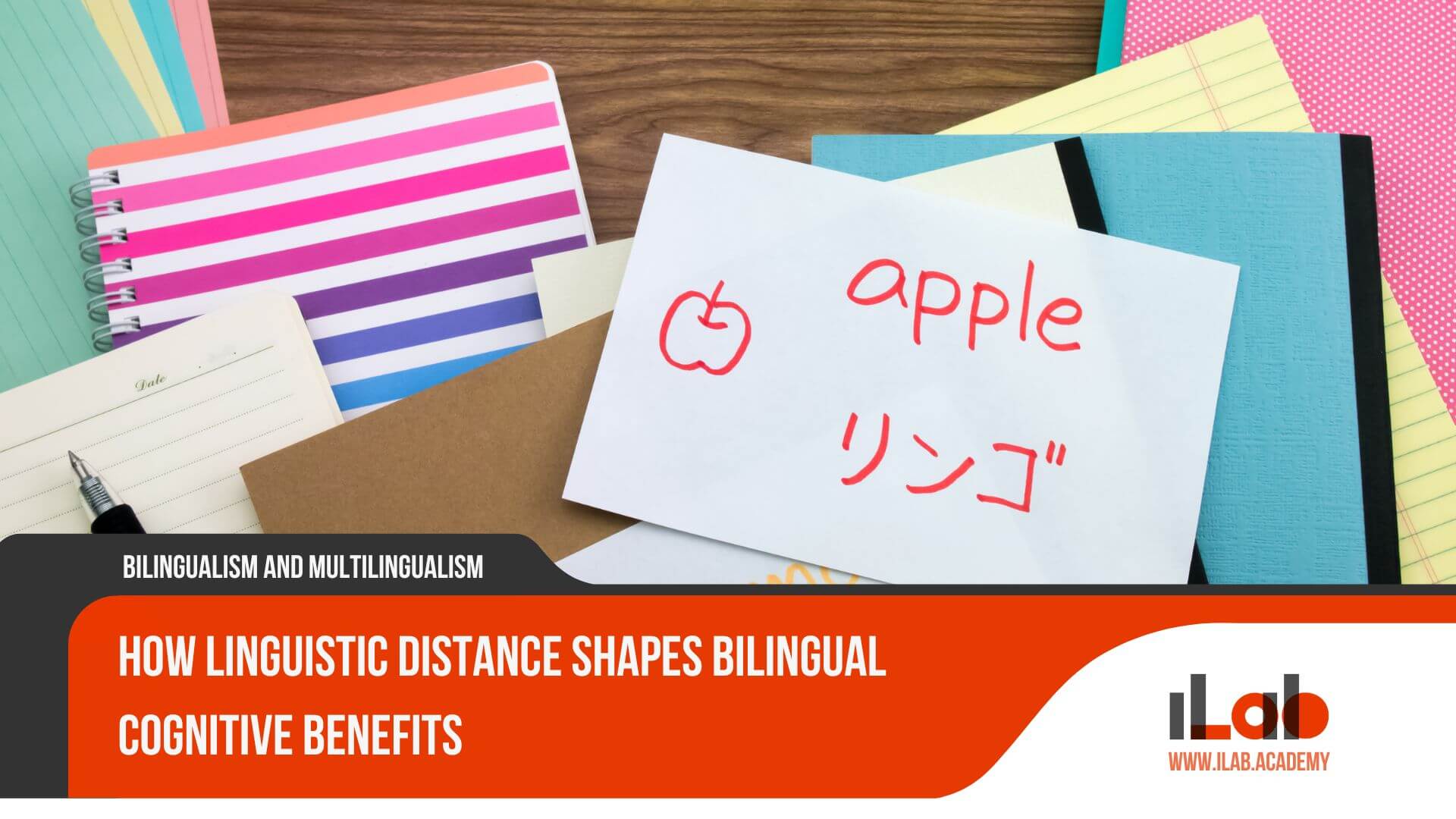Table of contents
Linguistic distance significantly influences bilingual cognitive benefits. When two languages are closely related, bilinguals often experience enhanced cognitive flexibility and working memory. Conversely, managing linguistically distant languages typically boosts inhibitory control and problem-solving skills. This cognitive workout can improve brain efficiency and delay cognitive decline, offering long-term mental health advantages. High school students studying distantly related languages might find these benefits particularly pronounced. Understanding this relationship encourages strategic language learning choices and highlights the brain-boosting power of bilingualism. Imagine the potential gains when you challenge yourself with new languages—you might be surprised by the brainpower you unlock.
Key Takeaways
- Linguistic distance influences the cognitive demands of bilingualism, impacting problem-solving and multitasking skills.
- Managing cross-linguistic interference in distant languages enhances executive functions like inhibition and working memory.
- Closer language pairs may lead to better cognitive flexibility and working memory.
- Bilingual individuals speaking distant languages might build a more robust cognitive reserve, delaying cognitive decline.
- Educational and cognitive health programs should consider linguistic distance to maximize cognitive benefits.
Theoretical Background
To understand the cognitive benefits of bilingualism, it is essential to delve into the concept of cognitive reserve and the models of language control utilized by bilingual individuals. Cognitive reserve (CR) refers to the brain’s resilience to neuropathological damage, essentially acting as a buffer that helps maintain cognitive function despite aging or disease. Life experiences, such as engaging in bilingualism, significantly contribute to building this reserve. Imagine your brain as a muscle; the more you use it, the stronger it gets. Bilingualism serves as a workout for your brain, enhancing its efficiency and flexibility.
Modeling language control in bilinguals involves understanding how they manage cross-linguistic interference. This process is overseen by a language control system, which is intricately linked to the domain-general executive control system. This system is responsible for essential cognitive processes like inhibition, cognitive flexibility, and working memory. Bilinguals are constantly training this system, as they frequently switch between languages and inhibit one language while using another. This ongoing mental exercise can lead to improved executive functions over time. Have you ever wondered how this impacts aging? It turns out that this constant brain workout can delay cognitive decline, promoting healthier cognitive aging.
Measuring Linguistic Distance
Quantifying linguistic distance involves assessing the similarity or difference between languages using various methods such as Levenshtein distance and genetic proximity. Levenshtein distance measures how many changes—insertions, deletions, or substitutions—are needed to transform one word into another, providing a tangible metric of difference. Genetic proximity, on the other hand, examines the historical and evolutionary relationships between languages.
For example, English and Swedish have a closer linguistic distance due to their shared Germanic roots, making them relatively easier to learn and switch between. Conversely, English and Italian, despite both being Indo-European languages, belong to different subfamilies, resulting in a more considerable linguistic distance. This greater distance often requires more cognitive effort to manage bilingualism effectively.
Understanding these measurements is crucial as they help researchers determine how linguistic distance influences cognitive demands. Specifically, the greater the distance, the more challenging it becomes to juggle two languages, potentially leading to heightened cognitive benefits in areas such as problem-solving and multitasking. By appreciating these complexities, we can better understand how bilingualism shapes our cognitive abilities, paving the way for enhanced educational strategies and cognitive health initiatives.
Effects of Bilingualism on Executive Functions
Building on the understanding of linguistic distance, the effects of bilingualism on executive functions become particularly relevant. Executive functions encompass cognitive processes such as inhibition, cognitive flexibility, and working memory—skills essential for problem-solving and adapting to new situations. Bilingual individuals often show enhanced performance in these areas due to the continuous need to manage two languages. This constant juggling acts like a mental workout, strengthening the brain’s executive control system.
However, the cognitive benefits of bilingualism are not uniform. Some studies reveal that bilinguals outperform monolinguals in tasks requiring executive functions, while other research finds no significant differences. This discrepancy suggests that other factors, such as linguistic distance, play a crucial role. Linguistic distance refers to the degree of similarity or difference between the two languages spoken by bilinguals. When the languages are more distinct, the cognitive demands may increase, potentially amplifying the cognitive benefits.
Understanding these nuances is essential for educators and policymakers aiming to harness the cognitive advantages of bilingualism. By recognizing the factors that influence these benefits, strategies can be developed to optimize cognitive health and promote successful aging in bilingual populations.
Influence of Linguistic Distance on Cognitive Effects
The influence of linguistic distance on cognitive effects is a critical factor in understanding the variability in bilingual cognitive benefits. Linguistic distance (LD) refers to how similar or different two languages are. This distance can significantly impact how bilingualism shapes cognitive functions such as inhibition, cognitive flexibility, and working memory.
Studies suggest that closer language pairs, like Spanish and Italian, often result in better executive function outcomes. This might be because these languages share more similarities, making it easier to switch between them. On the other hand, learning and managing more distant language pairs, like English and Mandarin, can be more cognitively demanding. This increased effort can lead to different cognitive benefits, possibly enhancing cognitive reserve in unique ways.
The cognitive demands of bilingualism can vary depending on the phase—whether one is learning the languages or actively using them. For instance, learning distant languages may require more mental effort initially, while managing closer languages could demand more effort in the control phase. Understanding these nuances helps us appreciate how linguistic distance can dynamically modulate the cognitive advantages of bilingualism, offering valuable insights into educational and cognitive health strategies.
Ultimately, recognizing the role of linguistic distance enriches our understanding of how bilingualism can be tailored to maximize cognitive benefits.
Study on Aging Bilinguals
Examining the impact of linguistic distance on cognitive effects, the study on aging bilinguals focused on cognitively healthy adults aged 60 and above, assessing their language background, cognitive performance, and the linguistic distance between their languages. The objective was to determine how the similarity or difference between the two languages spoken by these individuals influenced their cognitive abilities, particularly executive functions.
To achieve this, the study utilized the Flanker task, a cognitive performance assessment tool that measures executive control. This task helped researchers understand the interplay between linguistic distance and bilingual experience in shaping cognitive outcomes. The following key elements were considered in the study:
- Participants’ Language Background: Detailed information on the participants’ proficiency and usage of both languages was collected to provide a comprehensive overview of their bilingual experience.
- Cognitive Performance Assessment: The Flanker task was administered to evaluate the participants’ executive control, focusing on their ability to manage and switch between languages.
- Linguistic Distance Measurement: The degree of similarity or difference between the two languages spoken by the participants was quantified to analyze its impact on cognitive performance.
- Age-Related Cognitive Variations: Differences in cognitive performance based on age and bilingual experience were examined to understand the broader implications of linguistic distance on aging cognitive health.
This study’s meticulous approach offers valuable insights into the cognitive benefits of bilingualism in aging populations.
Results
While investigating the cognitive effects of bilingualism, the study revealed that linguistic distance significantly modulates executive performance, displaying distinct patterns for language pairs with varying degrees of similarity. Specifically, bilinguals speaking closely related languages, such as Spanish and Italian, exhibited different cognitive benefits compared to those managing more linguistically distant pairs, like English and Mandarin.
The research highlighted that those fluent in similar languages often showed enhanced cognitive flexibility and working memory. This suggests that the ease of switching between closely related languages may facilitate certain executive functions more effectively. On the other hand, bilinguals handling distant languages demonstrated superior inhibitory control, likely due to the increased cognitive demands of managing two very different linguistic systems.
Additionally, the study underscored the intricate relationship between linguistic distance, bilingual experience, and cognitive reserve. It found that speakers of distant language pairs might build a more robust cognitive reserve, potentially due to the higher mental effort required. This could imply a greater resilience to cognitive decline as they age.
Discussion
Building on the results, the discussion seeks to interpret how linguistic distance shapes the cognitive benefits of bilingualism and its implications for cognitive health interventions. Understanding how the similarity or difference between two languages can influence cognitive demands is crucial for developing effective educational and health strategies. The findings indicate that greater linguistic distance can enhance cognitive flexibility and inhibition due to the increased cognitive load required to manage and switch between dissimilar languages. Conversely, closely related languages may offer less cognitive challenge, potentially leading to different cognitive benefits.
To emphasize the practical implications:
- Intervention Design: Educational programs should consider linguistic distance when developing bilingual curricula to maximize cognitive benefits.
- Cognitive Health Strategies: Tailored cognitive health interventions can be more effective by incorporating the concept of linguistic distance.
- Research Directions: Future studies should explore how varying degrees of linguistic distance affect different aspects of executive function to refine our understanding further.
- Policy Making: Policymakers can use these insights to promote bilingualism in ways that enhance cognitive reserve and delay cognitive decline.
Conclusion
The study by Gallo et al. (2023) reveals that linguistic distance significantly influences the cognitive benefits of bilingualism, particularly in aging populations. Bilingual individuals who navigate languages with greater linguistic distance exhibit enhanced executive functions, such as cognitive flexibility and working memory. These findings underscore the importance of considering linguistic factors in cognitive health strategies. Ultimately, fostering bilingualism, especially with diverse languages, can contribute to successful cognitive aging and improved quality of life.





